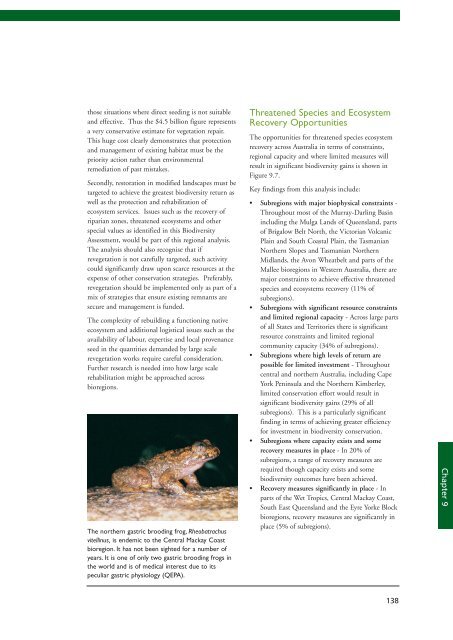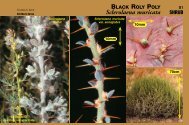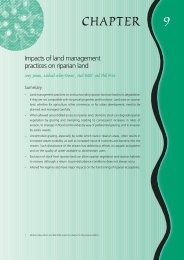australian terrestrial biodiversity assessment 2002 - Land and Water ...
australian terrestrial biodiversity assessment 2002 - Land and Water ...
australian terrestrial biodiversity assessment 2002 - Land and Water ...
Create successful ePaper yourself
Turn your PDF publications into a flip-book with our unique Google optimized e-Paper software.
those situations where direct seeding is not suitable<br />
<strong>and</strong> effective. Thus the $4.5 billion figure represents<br />
a very conservative estimate for vegetation repair.<br />
This huge cost clearly demonstrates that protection<br />
<strong>and</strong> management of existing habitat must be the<br />
priority action rather than environmental<br />
remediation of past mistakes.<br />
Secondly, restoration in modified l<strong>and</strong>scapes must be<br />
targeted to achieve the greatest <strong>biodiversity</strong> return as<br />
well as the protection <strong>and</strong> rehabilitation of<br />
ecosystem services. Issues such as the recovery of<br />
riparian zones, threatened ecosystems <strong>and</strong> other<br />
special values as identified in this Biodiversity<br />
Assessment, would be part of this regional analysis.<br />
The analysis should also recognise that if<br />
revegetation is not carefully targeted, such activity<br />
could significantly draw upon scarce resources at the<br />
expense of other conservation strategies. Preferably,<br />
revegetation should be implemented only as part of a<br />
mix of strategies that ensure existing remnants are<br />
secure <strong>and</strong> management is funded.<br />
The complexity of rebuilding a functioning native<br />
ecosystem <strong>and</strong> additional logistical issues such as the<br />
availability of labour, expertise <strong>and</strong> local provenance<br />
seed in the quantities dem<strong>and</strong>ed by large scale<br />
revegetation works require careful consideration.<br />
Further research is needed into how large scale<br />
rehabilitation might be approached across<br />
bioregions.<br />
The northern gastric brooding frog, Rheobatrachus<br />
vitellinus, is endemic to the Central Mackay Coast<br />
bioregion. It has not been sighted for a number of<br />
years. It is one of only two gastric brooding frogs in<br />
the world <strong>and</strong> is of medical interest due to its<br />
peculiar gastric physiology (QEPA).<br />
Threatened Species <strong>and</strong> Ecosystem<br />
Recovery Opportunities<br />
The opportunities for threatened species ecosystem<br />
recovery across Australia in terms of constraints,<br />
regional capacity <strong>and</strong> where limited measures will<br />
result in significant <strong>biodiversity</strong> gains is shown in<br />
Figure 9.7.<br />
Key findings from this analysis include:<br />
• Subregions with major biophysical constraints -<br />
Throughout most of the Murray-Darling Basin<br />
including the Mulga <strong>L<strong>and</strong></strong>s of Queensl<strong>and</strong>, parts<br />
of Brigalow Belt North, the Victorian Volcanic<br />
Plain <strong>and</strong> South Coastal Plain, the Tasmanian<br />
Northern Slopes <strong>and</strong> Tasmanian Northern<br />
Midl<strong>and</strong>s, the Avon Wheatbelt <strong>and</strong> parts of the<br />
Mallee bioregions in Western Australia, there are<br />
major constraints to achieve effective threatened<br />
species <strong>and</strong> ecosystems recovery (11% of<br />
subregions).<br />
• Subregions with significant resource constraints<br />
<strong>and</strong> limited regional capacity - Across large parts<br />
of all States <strong>and</strong> Territories there is significant<br />
resource constraints <strong>and</strong> limited regional<br />
community capacity (34% of subregions).<br />
• Subregions where high levels of return are<br />
possible for limited investment - Throughout<br />
central <strong>and</strong> northern Australia, including Cape<br />
York Peninsula <strong>and</strong> the Northern Kimberley,<br />
limited conservation effort would result in<br />
significant <strong>biodiversity</strong> gains (29% of all<br />
subregions). This is a particularly significant<br />
finding in terms of achieving greater efficiency<br />
for investment in <strong>biodiversity</strong> conservation.<br />
• Subregions where capacity exists <strong>and</strong> some<br />
recovery measures in place - In 20% of<br />
subregions, a range of recovery measures are<br />
required though capacity exists <strong>and</strong> some<br />
<strong>biodiversity</strong> outcomes have been achieved.<br />
• Recovery measures significantly in place - In<br />
parts of the Wet Tropics, Central Mackay Coast,<br />
South East Queensl<strong>and</strong> <strong>and</strong> the Eyre Yorke Block<br />
bioregions, recovery measures are significantly in<br />
place (5% of subregions).<br />
138<br />
Chapter 9




